 AT&T TV launched today in 10 U.S. cities — all within AT&T’s U-verse/fiber service areas, providing a comparable TV lineup to the DirecTV satellite service with discounts for bundling internet access.
AT&T TV launched today in 10 U.S. cities — all within AT&T’s U-verse/fiber service areas, providing a comparable TV lineup to the DirecTV satellite service with discounts for bundling internet access.
Customers can begin signing up today for the service in Orange and Riverside, Calif., West Palm Peach, Fla., Topeka and Wichita, Kan., Springfield and St. Louis, Mo., and Corpus Christi, El Paso, and Odessa, Tex.
The service’s television lineup is closely comparable to the DirecTV satellite lineup, and AT&T intends its new streaming TV service to offer an alternative to those who do not want to install a satellite dish or deal with AT&T’s own U-verse TV. The biggest bundle discounts go to consumers who bundle internet and television service together. Video packages start at $59.99 and include a much larger lineup than AT&T’s streaming-only service targeting cord cutters — AT&T TV Now (formerly DirecTV Now).
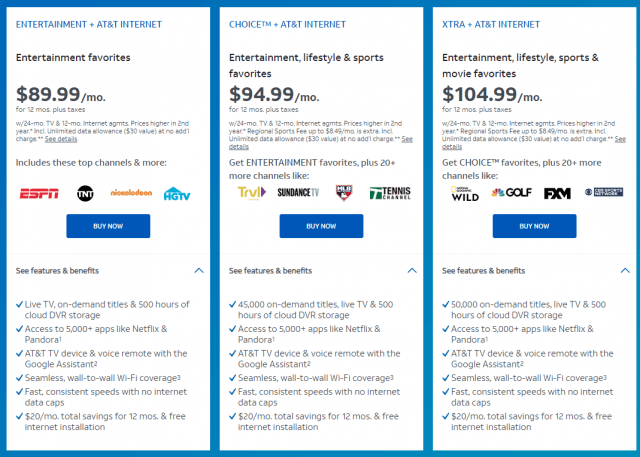
These plans bundle television and internet from AT&T.
Customers bundling internet and TV service will find a deeply discounted 300 Mbps internet plan for $40 a month for the first year ($70 for gigabit service) and AT&T will include unlimited internet in any package bundling TV service (a $30/mo value). Installation fees are waived, but there is a $19.95 activation fee and an early termination fee of $15/mo for TV and $15/mo for internet for each month remaining on a two-year contract. AT&T TV requires a set-top box for each television and the first one is free. Each additional box is $120, payable up front or in 12 equal monthly installments of $10. The box is powered by Android TV and supports various apps and comes with a voice remote control.
Features include a 500-hour cloud DVR package, with recordings stored up to 90 days. You can record as many channels as you want at the same time, but we suspect premium movie channels may be excluded. The full lineup is available for streaming outside of your home and includes local major network affiliates in most markets. AT&T TV supports 4K streaming as well, and since AT&T is waiving its data cap for TV and broadband customers, you will not have to worry about any data caps. Up to three people can stream your TV lineup simultaneously. Keep in mind each television represents one stream.
AT&T makes life complicated for would-be customers with a panoply of confusing discounts, rebates, and savings that often expire after one year into a two-year contract. Customers should pay careful attention to the breakdown of the charges AT&T provides and mark your calendar so you are not surprised by the gradually rising bill.
Stop the Cap! put together a package to give you an idea of what to expect. We selected the “Ultimate” TV package, which includes just about every English language channel on the lineup. Mysteriously, the biggest exception is Hallmark Movies and Mysteries. Like AT&T TV Now, this channel is only available on the cheapest package, which makes no sense to us.
Let’s start with the TV package:
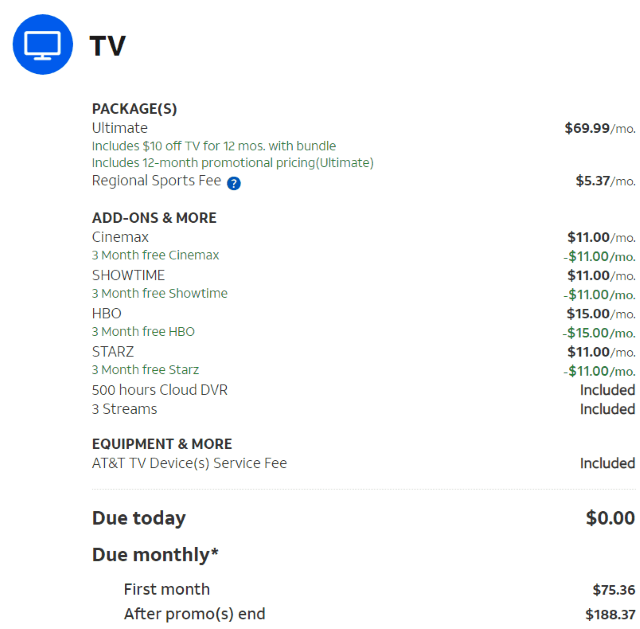
Note that the TV package is discounted significantly, but only for the first 12 months of your 24 month commitment. Also note the “Regional Sports Fee” which varies depending on the city. In this case, we chose Topeka, Kan. to build this package.
Premium movie channels are provided free for the first 90 days. The prices shown represent à la carte pricing. If you want these channels going forward, ask if a package price is available and bundle them for additional savings.
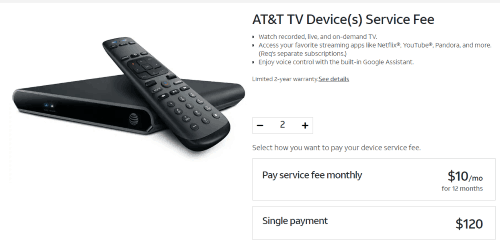
AT&T’s mini set-top box has been tested by DirecTV Now customers for almost a year. It earned mixed reviews and can be cumbersome. Keep in mind the first box is free, but each additional box costs $120, payable up front or in installments.
AT&T’s pricing for the first three months is very low, then higher prices kick in for the next 12 months unless you cancel those four premium movie channels, with still higher pricing during the second year of the two-year contract. AT&T makes things needlessly complicated and this explains the subscriber confusion about billing issues that is common with AT&T. But AT&T cannot be accused of not letting you know what to expect. In 2020, you could be paying $188.37 just for your TV lineup:
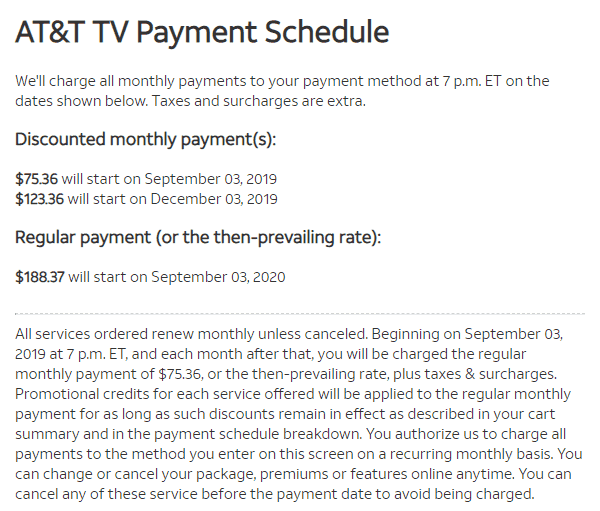
Next up is the internet portion of our order:
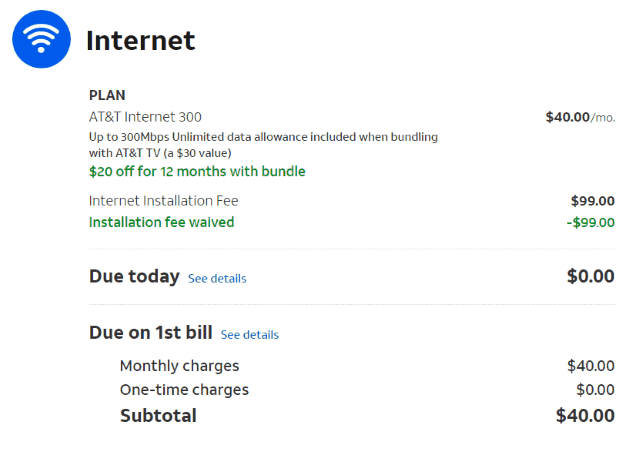
Note you get a $20 discount, but only during the first year. The fact you seem to owe nothing when placing the order does not mean the first month is free. AT&T is not sure what they will charge you because: “The monthly total on your bill may vary depending on your billing date and prorated monthly fees, based on the date of installation, that are applied to your account. Quoted prices don’t include taxes, fees, surcharges, shipping, or other charges including city video cost-recovery and Universal Services Fund fees, where applicable.” AT&T wouldn’t tell us exactly what those charges were.
Finally, AT&T includes some additional savings from various promotions, including an odd double gift card promotion awarding a total of $100 in Visa gift cards for signing up online:

The gift card promotion ends September 15, 2019 but will likely reappear. Customers have to submit their rebate request soon after service is ordered and spend the gift card(s) within six months to avoid forfeiture.
AT&T plans to roll out AT&T TV nationwide during 2020. But the company seems to be favoring markets where it already offers broadband service. It is not known if or when AT&T will introduce this streaming alternative to DirecTV in areas where other phone companies dominate. Customers do not have to use AT&T for internet access to subscribe.


 Subscribe
Subscribe
It’s disappointing but also predictable.
AT&T seemed to be going big on video when others were getting out. What sticks out about those plans is that they are so expensive compared to Netflix or Amazon Prime or Disney+. Maybe somebody thinks it is worth it, but for $20 a month you can buy a lot of on-demand entertainment in a world where only some content is better live.
This is an attempt to keep the old business model running, increasing prices to make up for the customers they are losing, until they can’t run it anymore.
Sad.